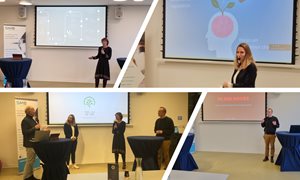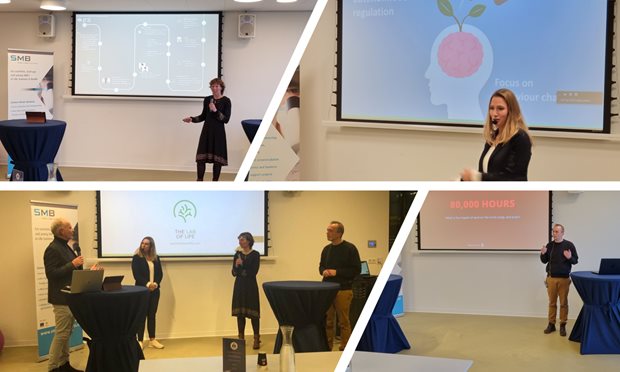

Science meets Business Healthy Brains for Healthy Work
At the start of the event on December 2, 2022, Lucy Overbeek from Healthy Brain Study informed us on the why and moreover the how of the study that started in 2017 to unrafel the brain of people in their 30’s from the Nijmegen region to understand human behavior in daily life. This unique source of data (90 Terabyte!) is used by a.o. Erik Bijleveld and his colleagues to study the impact of work on the mind, body, and brain. Erik singled out two themes for this event; Mental fatigue and Sitting behavior (‘Sitting is the new smoking’). Finally Doeska Anschutz (Founder of The Lab of Life) explained how the data from the HBS and the scientific evidence from Erik’s team has been used to develop a behaviour change training for youth and adults to increase wellbeing.
Take a look at the webinar here.

Campus meeting Healthy Brain Study
In our campus meeting on the 17th of January, 2022, 45 people from 20 research institutes from Radboud campus met online to hear about the Healthy Brain Initiative from Roshan Cools and to get an update on the progress of the Healthy Brain Study by Lucy Overbeek. Thereafter, the attendees joint parallel sessions for in-depth discussion of Healthy Brain topics. Compared to earlier campus meetings, we observed that there is progress in the level of the discussions, but real interdisciplinary in-depth discussions keep difficult. However, important steps were taken in understanding which questions researchers from other disciplines have about your area of expertise. Also, the other way around, it is better understood why you (often) will not receive a simple answer from an expert from another discipline, but the answer ‘it depends’.
If you want to go fast, go alone.
If you want to go far, go together.
Please take a look at all the topics here:
1. Biology of healthy work (Erik Bijleveld, Thijs Eijsvogels)
Across the lifespan, fulltime employees spend about 80.000 hours on work. In terms of learning, brain plasticity, and health, this is an enormous amount of time. Problematically, ‘working’ is not necessarily a healthy activity: work stress may affect the immune system, the cardiovascular system, and the metabolic system. Also, work often involves sitting on a chair for long stretches of time. Yet, for many people, work contributes to well-being: it provides a source of structure, income, social contact, meaning, identity and self-esteem. As work is thus a multifaceted phenomenon, we believe that much can be gained from an interdisciplinary approach. For example, work psychologists and management scientists understand the ecology of work, whereas the Radboudumc has many specialists on the biological systems potentially affected by work. The Healthy Brain Study can serve as a springboard for interdisciplinary collaboration on the topic healthy work. In this session, we will explore the possibilities.

2. A real life biopsychosocial mental health-model (Maartje Luijten)
The biopsychosocial model has been the dominant mental health model in the past decades. However, studies addressing all components of the biopsychosocial model are very rare, and even more so when it comes to integration of these components in real life. Traditionally these research domains are quite separated or study at most two factors of the biopsychosocial model. The Healthy Brain Study provides the unique opportunity to study mental health more holistically and to integrate biological, psychological and social factors. If we do so, we can tap into the core of human living, for example by linking social functioning to several mental health and cognitive functioning outcomes, thereby taking into account biological systems such as systemic inflammation or brain functioning. Next to these fundamental insights, results of the Healthy Brain Study can stress the importance of understanding biopsychosocial cascades, as such results are informative for (precision-based) intervention- and prevention development, and for advising policy-makers on how to improve mental health and well-being of the population. In this session we will explore options to study mental health from a holistic, interdisciplinary, and real-life perspective.

3. The language of well-being (Florian Hintz)
Using language is one of the most complex skills that we as humans possess. We are able to communicate our intentions and feelings using language, language can make us smile, language can hurt. We know that sleep, living conditions, and health profoundly influence our well-being. How language is related to our well-being is however still unclear, despite indications that language can influence cognitive and emotional functioning. Although all of us use language every day in speaking and listening, reading and writing, there exist vast differences between adult users of the same language. The Healthy Brain Study measures participants’ language skills in great depth and assesses aspects of their reading habits. During this session, we will provide an overview of the available language-related measures and will discuss ideas for a project revolving around ‘the language of well-being’.

4. Neurobiology of social inclusion (Jana Vyrastekova)
Social inclusion is individual’s feeling of being valued, connected and appreciated in a group. It is often proxied by friendships and social network positions, but also by measures of subjective well-being. Socially included individuals are embedded in their group, understand and perceive the groups’ social norms as relevant for guiding their behavior, and this in turn increases the predictability of social interactions and decreases stress and uncertainty. Social inclusion is associated with lower loneliness - and is implied as a protective factor for physical and mental health. Social inclusion is also a normative ideal expressed across societal dimensions (education, labor market, citizenship), but often disputed as too costly to be implemented in practice. Costs of failed social inclusion, in terms of the health, economic and social consequences are poorly understood. Moreover, the concept of social inclusion remains elusive, and suffers from fractioned definitions for each context and group. During this session, we will discuss which neurobiology data from the Healthy Brain Study we should look at when studying the biology of social inclusion. Bringing to the table the methodology of behavioral and experimental economics, the intention of this discussion table is to merge forces to develop research questions on neurobiology of social inclusion.
5. Citizen science for dummies (Kris Bevelander)
In traditional designs, scientists test hypotheses that are often based on previous findings within their research domain or their intuitions. However, people living in or with specific conditions (i.e., being in their thirties and going through a key life event) may have additional insight on top of existing expert-knowledge. These insights are uncovered by a citizen science platform. The essence of the platform is to leverage collective intelligence from a large group of participants versus a smaller number of experts. This can reveal topics and research questions that have a significant influence on people’s behavior in the real world and their health status, which experts may have left untouched. By giving citizens a voice in scientific research, it can contribute considerably to the valorization of research results. In this session, we will explain how you can use citizen science in your research, and our platform in specific.
6. Imaging-derived phenotypes for dummies (Koen Haak and Anil Man Tuladhar)
This session aims to provide an overview of the possible measures that can be derived from the (functional) MRI data that is acquired in the Healthy Brain Study. These so-called imaging-derived phenotypes (IDPs) are based on processed MRI data and provide meaningful information about the brain’s structural and functional properties, such as the thickness of the cortical gray matter, the size of certain specialized brain areas, and the functional connectivity strength between different pairs of brain areas. IDPs are the main building blocks for subsequent analyses that, for instance, try to link the properties of the brain to behavioral variables, or using them as intermediate phenotypes for researchers interested in linking genetic information to high level cognition or behavior. In this session, we provide an overview of IDPs that can be extracted from the available data for setting up your future studies aimed at understanding how different behaviors are underpinned by the brain.


7. Cognition for dummies (Joukje Oosterman)
Cognition provides the foundation of human being – it plays a pivotal role in our daily life activities and thereby is a key factor allowing us to function independently. However, the heterogeneity of cognition and the neural underpinnings of diverse cognitive processes remain less well understood. Moreover, cognition is intrinsically linked to different disorders and symptoms, showing a bidirectional relationship with the different conditions. For example, different cognitive capabilities have been linked to the susceptibility to develop a psychological disorder, whereas the subsequent presence of such a disorder may cause a decline in these same cognitive functions. Cognitive functioning is thereby one of the most important signatures of a healthy brain, and a key factor in understanding health and disease. During this session, we discuss how the Healthy Brain Study shapes an optimal context to further elaborate on these interactions and correlates of cognitive functioning.


Discovery sprint session Integrate mobile/wearable data
In November 2021 we organized a ‘discovery sprint session’ at Holthurnsche Hof in Berg en Dal! The session was the kickstart of our effort to integrate mobile/wearable data collected in the Healthy Brain Study and opens up this immensely rich data resource for real-world behaviour for all of you. Read MoreDiscovery sprint session Integrate mobile/wearable data
In November 2021 we organized a ‘discovery sprint session’ at Holthurnsche Hof in Berg en Dal! The session was the kickstart of our effort to integrate mobile/wearable data collected in the Healthy Brain Study and opens up this immensely rich data resource for real-world behaviour for all of you.

Our second webinar A great success!
7 June 2021 In addition to the progress of the study, a look behind the HBS scenes, and participant Anke, the central topic of the webinar was super memory. Dr. Boris Konrad discussed memory techniques and showed us its benefits for our daily lives and work. go to page
Healthy Brain at Health Valley Event
5 March 2021 Healthy Brain; can companies and research really work together? go to page
